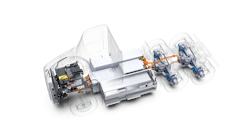Meritor is on track to bring its electric powertrain from proof of concept into production this year, with several OEM partnerships in the works. And as the commercial vehicle (CV) industry continues to move the needle on electrification and zero-emission operations, T.J. Reed, vice president of Global Electrification for Meritor, foresees an even greater push for technological advancements over the next five years.
On February 2, Meritor announced that the production of its 14Xe all-electric, fully integrated, commercial electric powertrain for medium and heavy duty commercial vehicles will begin mid-2021.
Part of Meritor’s Blue Horizon advanced technology portfolio, the 14Xe e-powertrain has been tested in various conditions around the world with several OEMs, vehicle types, and applications, Reed noted. In 2018, Meritor created its Blue Horizon technology brand, which operates under three pillars: efficiency, connectivity, electrification.
Meritor received the first Class 8 truck production contract for electric powertrains in the industry in January 2020, when it announced an agreement with Paccar to be a non-exclusive supplier of electric powertrains. Meritor will supply the tandem axle 14Xe for heavy duty applications for Peterbilt and Kenworth tractors. A year later, Meritor is nearing production and preparing to put the vehicles on the road, Reed said.During a February 2 virtual media roundtable, Reed shared updates to Meritor’s Blue Horizon portfolio of electrification solutions and unveiled several new partnerships with OEMs, including Autocar, Lion Electric, and Volta Trucks.
14Xe production
The 14Xe electric powertrain, which will be produced at Meritor’s facilities in Asheville and Forest City, North Carolina., is designed to provide efficiency, performance, weight savings, and space utilization. Key features of the 14Xe e-powertrain, compared to remote mount systems, include a tighter turning radius due to a shorter wheelbase; increased room between frame rails for additional battery capacity, which extends the range of the vehicle; and lighter weight.In a video presentation on the development and industrialization of the 14Xe, John Bennett, Meritor’s chief technology officer, pointed out that Meritor is designing its electric motor from the ground up, specifically for the application, and for integration into the axle.
“Integration of an electric motor saves space and weight,” Bennett said, adding that to integrate an electric motor and a different speed transmission into a carrier on the axle “effectively and reliably is no small task.”
Reed explained that by nesting the integrated motor and multispeed transmission into the carrier saves about 30" of wheelbase and up to 500 lbs.
“The customer could translate that in different ways,” Reed said. “If you think about range application where you certainly have a lot of need for better maneuverability and that shorter wheelbase that provides a tighter train radius, they can use it for additional battery capacity. There is an opportunity to put batteries in between the rails, so they are actually nested and protected as well as adding additional capacity.”
Last year, Meritor acquired Transportation Power Inc. (TransPower) to position itself as a premier supplier of electrification technologies for commercial vehicles. California-based TransPower, which now operates under Meritor’s Global Electrification unit, supplies integrated drive systems, full electric truck solutions, and energy-storage subsystems to major manufacturers of trucks, school buses, refuse vehicles, and terminal tractors.
Reed noted that Meritor was attracted to TransPower as on opportunity to put its 14Xe drive system into the market through some early programs. In addition to its partnership with Paccar, Meritor supplied 14Xe electric axles for Freightliner's Innovation Fleet, as well as a production contract with Kalmar Ottawa to supply terminal tractors.
Through its TransPower acquisition, Meritor can provide the controls, electronics, and powertrain for a complete system, making it a “one-stop shop” for the OEM or fleet, Bennett added.
From a functional safety perspective, Meritor’s powertrain control module complies with Automotive Safety Integrity Level (ASIL) C-level ratings, the international standard for functional safety that applies to electrical and electronic systems consisting of hardware and software components in vehicles.
Moving forward, Meritor plans to scale up with a 17Xe axle for European applications in 2025 and a 12Xe, which Reed referred to as the “younger sibling of the 14Xe,” for use in applications like delivery vans, available beginning in 2023.
Regarding the future shift of braking systems for EVs and regenerative braking designs on electric powertrains, Reed explained that it's an "interesting design challenge because you have a foundation brake that you really don't need to use that much." He added that due to the way regulations are written right now, a stopping distance still has to be met, so there needs to be the brake torque or clamping effort to do that.
"So, brakes are probably overbuilt for EVs," Reed explained. "But what we're working on is, how can we slim down the mass? How can we have proper coatings on rotors and then take some additional weight and cost out of the system, but still have all the performance? Being a global brake supplier, that is absolutely on our roadmap. We're launching right now with off-the-shelf brakes just merely from a speed and complexity standpoint. The regulation really hasn't changed much. But as it does, we see an opportunity for the next generation of air disc brakes."
New partnerships, real-world feedback
Meritor also announced that it has secured three new business partnerships for the 14Xe axle: a five-year supply agreement with Autocar Trucks, an American specialty truck manufacturer, to supply its refuse vehicles with Blue Horizon 14Xe integrated e-powertrains in 2022; a three-year supply agreement with Lion Electric, a Canadian manufacturer of medium and heavy duty zero-emission vehicles, with production scheduled for mid-2021; and Volta Trucks, a London-based electric CV startup, for inner-city parcel and freight distribution, with a targeted production startup for 2022.
Meritor has secured a five-year supply agreement with Autocar Trucks to supply its refuse vehicles with Blue Horizon 14Xe integrated e-powertrains in 2022.Photo: Meritor
Although the industry is far from scalable adoption of electric vehicles for the linehaul market, beachhead segments like drayage applications and refuse are viable areas for widespread adoption. Reed explained that although lifecycles of the electric axles will be shorter than the seven- to 10-year lifecycles of a traditional axle, that’s not necessarily a bad thing.
“That’s just an industrywide phenomenon, which is great because that is what’s going to drive innovation — higher performance, lower cost, and new engines into the market,” he explained. “We want to learn early on and continue to refine the product.”
Part of Meritor’s learning experience will also come from insights gleaned as a sponsor for the North American Council for Freight Efficiency’s (NACFE) Run on Less – Electric initiative. Reed said Meritor and other NACFE partners will derive an unbiased, third-party independent view of electrification technology and strategies in real-world duty cycles.
“That’s solid gold feedback to anybody that’s developing a product,” Reed explained. “If you look at the information that comes back from [NACFE’s reports], it’s from some of the major fleets and OEMs, so it’s significant. Again, it’s part of this transition and learning process and the early papers on when and how or where the market transition now has to be informed by data that is real and from vehicles on the road.”
When it comes to potential fleet maintenance savings and total cost of ownership (TCO) for electric vehicles, Reed said the jury is still out. However, he projects that based on the number of reduced parts and the modularity of the design, Meritor is confident fleet TCO will trend in the right direction.
"We see our benefit as on the front end driving down the acquisition cost and certainly giving the benefit on the packaging, and really the optionality where they can add additional battery space or shorten the wheelbase," Reed explained. "That's the functionality of the vehicle.
"We've got decades of experience in the axle itself, the loading, and the gearing," he added. "The new components on the power electronics and motor are where we've been focusing a lot of our efforts."







